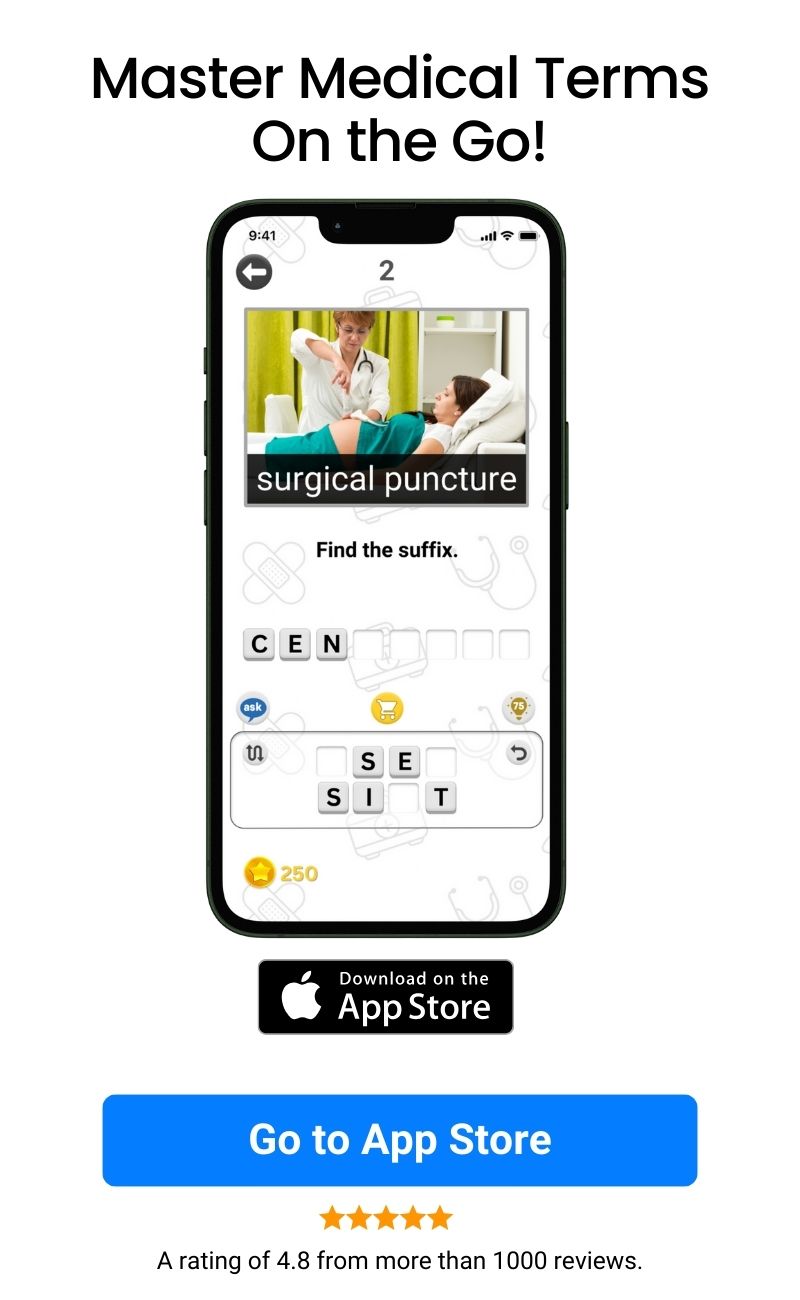Here’s the second quiz on the most common root words and combining forms used when referring to the sensory system.
Quick Review for the Quiz
Check out the flashcard version for a more detailed review.
| Word Root | Combining Form | Body Part or Condition |
|---|---|---|
| lent, phak, phac | lent/i, phak/o, phac/o | lens |
| mastoid | mastoid/o | mastoid bone |
| myring, tympan | myring/o, tympan/o |
tympanic membrane (eardrum)
|
| opt, ocul, ophthalm | opt/o, ocul/o, ophthalm/o | eye |
| ot, aur, aur | ot/o, aur/o, aur/i | ear |
| palpebr, blephar | palpebr/o, blephar/o | eyelid |
| phot | phot/o | light |
| pupill, core, cor | pupill/o, core/o, cor/o | pupil |
| retin | retin/o | retina |
| salping | salping/o |
auditory eustachian tube (also refers to the fallopian tube of the uterus)
|
| scler | scler/o | sclera |
| staped, stapedi | staped/o, stapedi/o | stapes (middle ear bone) |
| uve | uve/o | uvea |
| vestibul | vestibul/o | vestibule of the inner ear |
-
Question of
Find the combining form of the image pointed to.

-
lent/i
-
lens/o
-
blephar/o
-
opt/o
Correct Wrong
lent/i, phak/o or phac/o is a combining form that refers to "lens". An eye's lens is a transparent, biconvex structure that bends the light and focuses it for the retina, thus enabling you to see images in a clear, sharp manner.
-
-
Question of
Find the combining form of the image pointed to.

-
mastoid/o
-
vestibul/o
-
lent/i
-
core/o
Correct Wrong
mastoid/o is a combining form that refers to "mastoid bone". The mastoid bone, which is part of the temporal bone of the skull, contains many of these air cells grouped together. It has been speculated that the mastoid air cells protect the delicate structures of the ear, regulate ear pressure and, in the case of trauma, may protect the temporal bone as well.
-
-
Question of
Find the combining form of the image pointed to.

-
myring/o
-
lacrim/o
-
uve/o
-
drum/o
Correct Wrong
myring/o or tympan/o is a combining form that refers to "tympanic membrane (eardrum)". The tympanic membrane, or eardrum is a skin flap drum-like structure that separates the middle ear from the outer ear in the ear. As sound enters the ear canal, the eardrum vibrates, moving the vibrations to the three tiny bones in the middle ear. Sound is amplified by those bones, which send it to the cochlea, where hair cells ripple and produce an electrical signal. The auditory nerve transmits this signal to the brain. As well as helping you hear, the eardrum protects your middle ear from debris and bacteria that can cause infections.
-
-
Question of
Find the combining form of the image highlighted.

-
opt/o
-
ey/o
-
vestibul/o
-
audi/o
Correct Wrong
opt/o, ocul/o or ophthalm/o is a combining form that refers to "eye". The eye is the organ of sight.
-
-
Question of
Find the combining form of the image highlighted.

-
ot/o
-
ear/o
-
acoust/o
-
scler/o
Correct Wrong
ot/o, aur/o or aur/i is a combining form that refers to "ear". There are two important functions of the ear: hearing and maintaining body balance through the use of the vestibular system. The ear is commonly described as having three parts: the outer ear, the middle ear, and the inner ear.
-
-
Question of
Find the combining form of the image pointed to.

-
palpebr/o
-
eyelid/o
-
cycl/o
-
uve/o
Correct Wrong
palpebr/o or blephar/o is a combining form that refers to "eyelid". An eyelid is a skin fold that closes over the eye and provides protection for it. There are upper and lower eyelids. A muscle called the levator palpebrae superioris retracts the eyelid, opening the cornea to the outside and letting us see. It can be voluntary or involuntary.
-
-
Question of
Find the combining form of the image highlighted.

-
phot/o
-
light/o
-
chori/o
-
salping/o
Correct Wrong
phot/o is a combining form that refers to "light". Light or visible light is electromagnetic radiation that is detected by the human eye.
-
-
Question of
Find the combining form of the image pointed to.

-
pupill/o
-
labyrinth/o
-
choroid/o
-
salping/o
Correct Wrong
pupill/o, core/o or cor/o is a combining form that refers to "pupil". The pupil is a circular opening in the center of the iris (the pigment that gives the eye its color). Low light makes the pupil larger (dilation), while bright light makes it smaller (constriction).
-
-
Question of
Find the combining form of the image pointed to.

-
retin/o
-
aur/i
-
phot/o
-
vestibul/o
Correct Wrong
retin/o is a combining form that refers to "retina". An eye's retina is a layered structure located at the back of the eye. The retina converts light passing through the eye into electrical signals. Millions of light-sensitive cells (rods and cones) and nerve cells are found within the retina. Through the optic nerve, your retina transmits this information to your brain, which is what allows you to see.
-
-
Question of
Find the combining form of the image pointed to.

-
salping/o
-
eustach/o
-
phak/o
-
blephar/o
Correct Wrong
salping/o is a combining form that refers to "auditory eustachian tube (also refers to the fallopian tube of the uterus) ". Eustachian tubes, also known as auditory tubes, are tubes that connect the nasopharynx to the middle ear. Their primary function is to equalize pressure between the atmosphere and the middle ear.
-
-
Question of
Find the combining form of the image pointed to.

-
scler/o
-
outer/o
-
opt/o
-
cor/o
Correct Wrong
scler/o is a combining form that refers to "sclera". Sclera is the white layer surrounding most of the outside of the eyeball. The sclera serves as the protective wall of the eyeball. As a result, it helps maintain the form of your eyeball and safeguards it from injury. It is surrounded by a clear mucus membrane called the conjunctiva, which moisturizes (lubricates) the eye. Eyeball movement is assisted by muscles connected to the sclera.
-
-
Question of
Find the combining form of the image highlighted.

-
staped/o
-
middul/o
-
dacryocyst/o
-
cochle/o
Correct Wrong
staped/o or stapedi/o is a combining form that refers to "stapes (middle ear bone)". Together with the malleus and incus, the stapes forms the middle ear. They are together known as auditory ossicles. Their primary function is to transmit sound from the tympanic membrane to the middle ear. Among the bones in the human body, the stapes is the tiniest and lightest bone.
-
-
Question of
Find the combining form of the image pointed to.

-
uve/o
-
cycl/o
-
audi/o
-
dacry/o
Correct Wrong
uve/o is a combining form that refers to "uvea". Uvea is the layer of the eye in the middle that is under the white part of the eye called sclera. There are three parts to the uvea: (1) the iris, which is the pigmented portion of the eye; (2) ciliary body, which releases that clear transparent fluid within the eye; and (3) choroid, which is composed of vessels and tissues within the retina and sclera.
-
-
Question of
Find the combining form of the image highlighted.

-
vestibul/o
-
inn/o
-
pupill/o
-
labyrinth/o
Correct Wrong
vestibul/o is a combining form that refers to "vestibule of the inner ear". The vestibule is a cavity-like space that is located between and interconnects the cochlea and semicircular canals and aids in maintaining the body's equilibrium.
-




